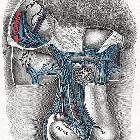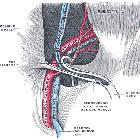scrotum




The scrotum (plural: scrota or scrotums) is a dual-chambered protuberance of skin and muscle that contains the testes, epididymides, and spermatic cord. It consists of two chambers separated by a septum. It is an extension of the perineum and is located between the penis and anus.
Gross anatomy
The scrotal wall is composed of several layers and normally measures 2-8 mm . It is composed of the following structures from superficial to deep :
- pigmented skin with rugal folds
- superficial fascia and dartos muscle
- external spermatic fascia: continuation of external oblique abdominis muscle aponeurosis
- cremasteric fascia: continuation of internal oblique abdominis muscle aponeurosis
- internal spermatic fascia: continuation of transversus abdominis muscle aponeurosis (transversalis fascia)
- tunica vaginalis
- tunica albuginea which covers the testes
A mnemonic to recall these layers is:
The tunica albuginea and tunica vaginalis respectively form the serous and fibrous layers around the testes, with a trace of fluid in between. Except for a small posterior area, the tunica vaginalis surrounds the testes .
See also: testicular and scrotal ultrasound
Contents
Arterial supply
Scrotal blood supply is formed by posterior scrotal branches of the perineal artery (from the internal pudendal artery), anterior scrotal branches of the deep external pudendal artery (from the common femoral artery) and the cremasteric artery (from the inferior epigastric artery).
Venous drainage
A series of scrotal veins accompany the arteries. Numerous arteriovenous fistulae are common.
Lymphatic drainage
As scrotal lymphatics do not cross the septum, lymphatics drain to the ipsilateral superficial inguinal nodes.
Innervation
- anterior 1/3: ilioinguinal and genitofemoral nerves (L1)
- posterior 2/3: perineal and posterior femoral cutaneous nerves (S3)
Variant anatomy
- congenital agenesis
- penoscrotal transposition (scrotum located superior and anterior to penis)
History and etymology
"Scrotum" is directly borrowed from the same Latin word, itself thought to be a variant of the Latin "scortum" (skin/hide, or things made with leather, such as a purse or quiver).
Related pathology
- hydrocele
- Fournier gangrene
- scrotal lymphedema (elephantiasis)
Siehe auch:
und weiter:

 Assoziationen und Differentialdiagnosen zu scrotum:
Assoziationen und Differentialdiagnosen zu scrotum:





